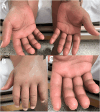Erasmus Syndrome, An Autoimmunity Paradox: A Case Report and Literature Review
- PMID: 40099047
- PMCID: PMC11912300
- DOI: 10.7759/cureus.79036
Erasmus Syndrome, An Autoimmunity Paradox: A Case Report and Literature Review
Abstract
Erasmus syndrome (ES) is a rare condition characterized by the link between crystalline silica exposure, with or without silicosis, and systemic sclerosis (SSc). Although first noted over a century ago, its underlying mechanisms remain unclear. However, it is indistinguishable from idiopathic SSc in the general population. Its clinical presentation is heterogeneous, depending on the affected systems, with notable features, including skin fibrosis, microstomia, telangiectasia, Raynaud's phenomenon, arthralgia, and interstitial lung disease. Currently, there is no unified consensus on its treatment; however, organ-specific therapy is a reasonable approach. We report the case of a 43-year-old miner diagnosed with diffuse cutaneous SSc, where ES was diagnosed after an exhaustive history was taken, occupational exposure was characterized, differential diagnoses were excluded, and radiological and histopathological evidence of pulmonary silicosis was presented.
Keywords: erasmus syndrome; ild interstitial lung disease; immunosuppressive agents; silicosis; systemic sclerosis.
Copyright © 2025, Arango et al.
Conflict of interest statement
Human subjects: Consent for treatment and open access publication was obtained or waived by all participants in this study. Conflicts of interest: In compliance with the ICMJE uniform disclosure form, all authors declare the following: Payment/services info: All authors have declared that no financial support was received from any organization for the submitted work. Financial relationships: All authors have declared that they have no financial relationships at present or within the previous three years with any organizations that might have an interest in the submitted work. Other relationships: All authors have declared that there are no other relationships or activities that could appear to have influenced the submitted work.
Figures




References
-
- Diagnostic classification of interstitial lung disease in clinical practice. Adegunsoye A, Ryerson CJ. Clin Chest Med. 2021;42:251–261. - PubMed
-
- Interstitial lung diseases. Wijsenbeek M, Suzuki A, Maher TM. Lancet. 2022;400:769–786. - PubMed
-
- Interstitial pneumonia with autoimmune features: an update. Valenzuela C, Cottin V, Ancochea J. Arch Bronconeumol (Engl Ed) 2018;54:447–448. - PubMed
-
- Systemic sclerosis-associated interstitial lung disease. Perelas A, Silver RM, Arrossi AV, et al. Lancet Respir Med. 2020;8:304–320. - PubMed
-
- Diffuse sclerodermia: its frequency; its occurrence in stone-masons; its treatment by fibrolysin—elevations of temperature due to fibrolysin injections. Bramwell B. https://pmc.ncbi.nlm.nih.gov/articles/PMC5271266/ Edinb Med J. 1914;12:387–401.
Publication types
LinkOut - more resources
Full Text Sources
